Motorcycles are a traditional product developed directly from the Victorian "Safety Bicycle". The riding position and steering systems are identical.
FF's are powered two-wheeled vehicles derived from first principles (Isaac Newton) on a clean sheet of paper.
"The FF two-wheeler is defined as a single track vehicle where the rider/s sit in tandem in much the same attitude and at much the same height as car passengers. The seat provided is similar, and sometimes identical, to a car seat." From the 1986 general Information Pack.
"A feet first two-wheeler has a low-mounted seat and seat back like a car". From the 1994 review "what ever happened"
In 1978, when I worked with Malcolm Newell on his Quasar project we agreed that an FF would have a seat base less than 20" (500mm) from the ground, at normal ride height.
To understand why FF two-wheelers are better than motorcycles some understanding of the physics is needed. Fortunately the laws are simple, defined by Isaac Newton a long time ago. These laws control the motion of matter above the quantum level and below the speed of light.
1. A body will remain at rest, or in uniform motion in a straight line, unless acted upon by a force.
2. The force required is proportional to the mass of the body and the degree of acceleration or deceleration.
3. Action and reaction are equal and opposite.
In this case 'the body' is represented by the centre of gravity (CG) of the vehicle and rider/s combined. This is the point through which all forces act.
This body can only be acted on by forces through the tyre ground contact patches, so these contact patches must stay in contact with the ground. Most motorcycles can easily lift a wheel from the ground, by accelerating, braking, or changing direction quickly, as in a "high-side" accident. Many users regard this as amusing and fun even though it reduces performance and safety.
Wheel lifting is not needed for control and thus motorcycles are unnecessarily dangerous. This is reflected in accident statistics.
Let's look at how reducing the height of the centre of gravity above the ground changes this.
1. Acceleration/deceleration
Looked at from the side any two wheeler can be reduced to a simple triangle. At the top is the centre of gravity. At each of the lower corners are the contact patches. The base of the triangle is formed by the distance between the two wheels, the 'wheelbase'. At a standstill gravity is the only force acting on the body. (All the following diagrams come from the review "what ever happened" )
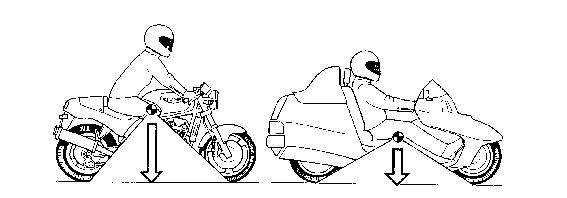
When the vehicle is accelerated a force is applied at the rear contact patch, pushing it forwards. This force acts on the centre of gravity, which reacts equally and ‘oppositely’. The force of gravity and the reaction to the force of acceleration form a combined line of force, or 'Vector', acting on the centre of gravity. When there is no acceleration the line of force is vertically downwards. If there was no gravity the line of force reacting to acceleration would be horizontal to the rear, opposite and equal to the accelerating force.
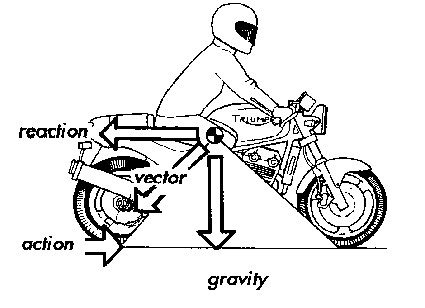
This vector line of force will be some angle between vertical and horizontal depending on the degree of acceleration. Acceleration equal to gravity (1G) will produce a reaction vector at 45 degrees to the ground. Modern tyres provide a maximum acceleration of almost 1.5G so the included angle with the ground can easily be less than 45 degrees.
Clearly, when the combined line of force runs behind the rear contact patch the vehicle will 'topple' lifting the front wheel. The opposite is also true under deceleration. It follows from this that, for a constant wheelbase, lowering the height of the centre of gravity will reduce the tendency to lift wheels off the ground.
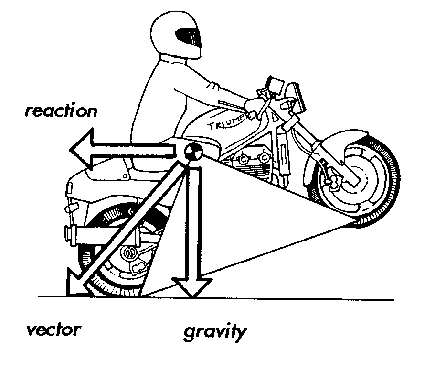
Strong acceleration or braking also makes one wheel rotate faster or slower. The reaction is for the vehicle to rotate round the wheel and this reaction adds to the tendency of the vehicle to lift the other wheel. This is called the 'torque' (Twisting) reaction.
It is possible to calculate the actual height of the CG above the ground at which wheel lifting will just not occur under maximum acceleration or braking, including the torque reaction. At this point the entire mass of the CG is acting through one contact patch.
There is some argument about the desirability of this "100% weight transfer" to one wheel. The grip developed by a tyre is dependant on the weight applied, if the tyre is not overloaded it will increase with weight and there is a view that 100% weight transfer is desirable and that anything less will result in earlier onset of wheelspin or wheel locking.
I disagree. I refer to an advertising slogan of the late twentieth century "Power is nothing without control"
A wheel with zero weight will develop zero grip, if a front wheel steering will be ineffective, if a rear wheel directional stability will be lost. This is undesirable in normal road conditions. It is also the case that maximum tyre grip is developed (at the expense of tyre life) at about 15% slip. This means that 85% weight transfer should produce maximum grip for acceleration or braking while retaining a degree of control. However road irregularities require a safety margin to avoid wheels, already down to 15% of normal loading, being thrown off the ground and I would not personally regard a road vehicle which transferred more than 75% of it's total weight as safe.
When all these factors are added to the calculation of optimum CG height it becomes clear that the CG should not be more than 500mm above the ground and that 400mm may be optimum. It is difficult to be precise about this because tyres, wheelbases and torque all vary between vehicles.
It is difficult to arrange a CG this low and it is clear that all motorcycles have a CG much too high for optimum control or performance.
2. Rapid direction changes.
My long-standing assertion that a high CG can result in wheels coming off the ground during rapid direction changes has produced some quite agitated dissent. A "high-side" accident, where a motorcycle goes into an oversteering slide, with the rear wheel sliding first, and then violently recovers because the rider has closed the throttle is a very rapid direction change. There are ample photos and video sequences showing how both wheels leave the ground and the rider the seat. Obviously a violent vertical acceleration of the CG has taken place. In less violent cases a momentary loss of grip occurs which may or may not be recovered.
To understand this effect we must look at the vehicle from the front. In this case it is apparent that the CG travels through an arc as the vehicle rolls about its contact patches. If we look at the maximum extent of this arc, as the vehicle rolls from one extreme of lean to the other, it can be seen that the CG is higher when the vehicle is upright than when it is fully rolled to one side or other. The CG rises and falls.
For this to happen there must be a force, and a reaction. This can only be provided by the ground. When the vehicle is upright the CG can only be lowered by reducing the reaction with the ground, it must be put into 'free-fall so that gravity can act unhindered. This is done by the rider steering the front contact patch out from under the CG, (This is called 'counter-steering')
When the vehicle is fully rolled to one side the CG can only be raised by increasing the reaction with the ground, overcoming gravity and accelerating it upwards. The rider 'counter-steers' into the turn, forcing the contact patch under the CG.
Look at the case where a rider wishes to turn rapidly from one side to the other.
First the rider accelerates the CG vertically. This increases reaction against the ground and increases tyre loading and hence grip. Now that now the CG is moving it will tend to keep doing so. Although moving through an arc it has a vertical component in it's movement.
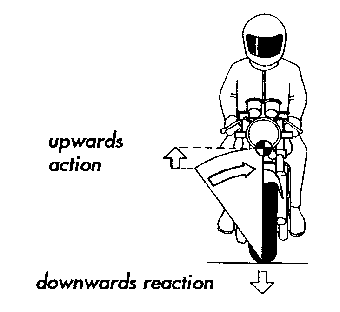
When the rider reaches upright and attempts to roll the other way the CG must be put into a degree of 'free-fall' as we have seen and this will reduce tyre loading and hence grip.
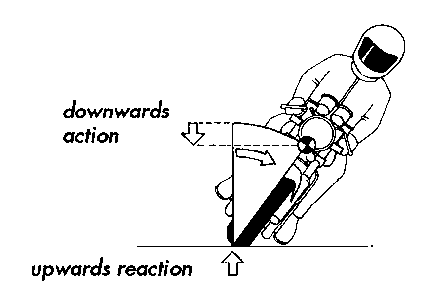
However we have just seen that the CG is also trying to continue moving vertically upwards, also reducing tyre loadings.
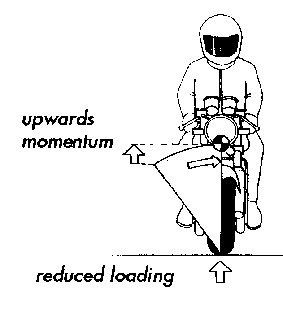
So now we have two effects combining to reduce tyre loadings. The degree to which this happens depends on the speed of the direction change and maximum unloading will occur somewhere near upright, exactly the point at which subtle direction changes are required by the rider as the vehicle is turned from one direction to the other. If this movement is fast enough, as in a 'high-side' the wheels will actually leave the ground.
Returning to the front view of the vehicle it will be seen that if the height of the CG is reduced the vertical movement of the CG is also reduced. Therefor lowering the CG reduces the tendency to unload the wheels at the top of a rapid direction change. It has become apparent during twenty five years of real-world development experience of various FF's that it is possible to eliminate 'high-side' type accidents simply by lowering the CG height.
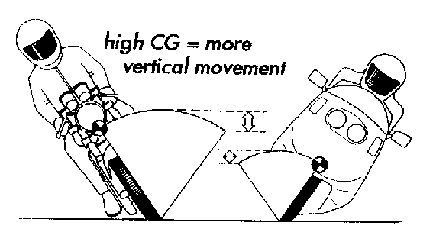
This concludes the primary safety case for FF two-wheeled vehicles. Reducing CG height extends the control envelope of the vehicle by keeping the wheels on the ground.
3. Performance
Performance is enhanced. A low CG vehicle can be turned faster, or driven with less effort than a high CG vehicle of identical weight.
Returning to the front view we saw that when the vehicle turns into a corner, rolling away from upright, this is done by unloading the tyres. The CG is put into a degree of free-fall. The higher the CG the further it must fall. Only gravity can provide the force needed for this so the force is a constant. However the distance is dependant on the CG height. So, to achieve a given angle of roll a high CG will take longer to fall than a low CG because it has further to go. The free-fall period will last longer before normal tyre loadings are restored and the vehicle will take longer to turn into a corner. This is immediately and obviously apparent when actually riding an FF.
Additionally, if we ignore the tyre loading issue, it can be seen that the length of the arc through which the CG travels increases as the CG height increases. A high CG must travel further than a low CG for a given degree of roll. It follows that for a given force it will be slower, or that for a given 'time to roll', more force is needed. This reduction in effort and increase in agility is also obvious when riding an FF.
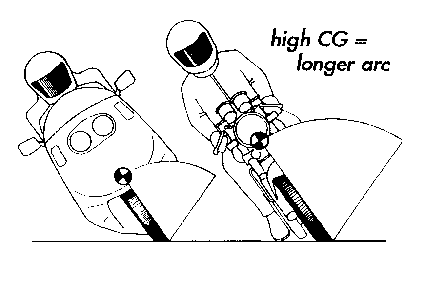
Finally, because the CG is lower it has less 'potential energy' In crude terms this means that a high CG vehicle will hit the ground with more force than a low CG vehicle if it's pushed off it's centre-stand! This means that the de-stabilising force, the tendency to fall over, is less in a low CG vehicle and if no control forces are applied it will be more stable.
4. Comparison of high and low CG cases.
So far we have described the basic vehicle physics. The practicalities of achieving a low CG have not been touched on although numerous other advantages will become apparent when we do. First, let's look at how the advantages we've identified above add up to provide an overwhelming advantage over conventional, high CG, two-wheelers.
Lets assume two vehicles of identical weight, power, rider ability, tyres, brakes and so on. One has a conventional CG height, the other has been lowered to 400mm (say) We are going to race them round a racetrack with one corner and a straight.
The lights go out and both vehicle accelerate at maximum rate.
The high CG vehicle must immediately close the throttle to avoid 'looping' as it transfers well over 100% of it's weight to the rear wheel. The low CG vehicle need only close the throttle if wheelspin becomes excessive, there is no control degradation. We can assume that it will comfortably out-accelerate the other 'wheelieing' vehicle. Bear in mind that as the front wheel lifts the CG rises rapidly, leading to a runaway reaction.
The corner appears and the brakes are applied. The high CG vehicle is limited in braking performance, it must keep the rear wheel on the ground sufficiently to retain control so it can arrive at the correct corner entry point. The low CG vehicle has only to avoid excessive front wheel locking, under which circumstances it will continue to keep going in a straight line. In practice the moderate weight transfer also means that the suspension will continue to work and the vehicle attitude will remain relatively level. This means that it will be less upset by the application brakes and can therefor brake harder, later, under better control.
When the brakes come off the high CG vehicle will spend a certain period recovering from it's extreme braking attitude before it can be turned into the corner.
When the vehicles turn into the corner we have seen that the low CG vehicle will turn in less time than the high CG vehicle. In practice this means it can be turned in later. So far then we have seen that the low CG vehicle has accelerated harder, then braked harder and turned into the corner later.
Next the vehicles must accelerate out of the corner. The high CG vehicle will unload it's front wheel, leading to excessive understeer and will be liable to a 'high-side' loss of control (and contact with the ground!) if this is balanced by enough power to make the rear wheel slide too. The low CG vehicle does not unload the front wheel to the same extent and is not subject to the high side danger. It can therefor be 'power-steered' out of the corner with relative ease.
It can be seen from this that in theory a low CG vehicle will have an overwhelming advantage. It is illegal to race low Cg two-wheelers because of the archaic regulations applied to motorcycle racing. In practice motorcycles brake so much earlier for corners that any following low CG FF riders must exercise great care to avoid running into them. If race-spec. FFs were allowed all current racing motorcycles would be immediately obsolete.
Obviously there are a small number of very talented athletes who can ride racing motorcycles with only one wheel on the ground at most times. This ability is irrelevant to road motor vehicle use and it is worth noting that the world championships involved are usually decided by rider injury.
When it comes to considering how to achieve a 400mm CG height there is only one practical solution. This is to dramatically lower the height of the heaviest single component. This component weighs the same in all two-wheelers, in lightweight motorcycles it may amount to a higher weight than all the other components combined. It's the rider.
There's also only one practical way of lowering the rider . The rider adopts a conventional sitting position. As in all other vehicles except motorcycles! Returning to the definitions at the top of this section we're talking about a normal, car-type, seat with a base less than 500mm (20") above the ground. This lowers the CG but it also provides other extremely useful advantages.
1. The seat back. The seat back is the single most important component. It reduces rider effort to levels below car driving (No lateral loads) More importantly it makes it very difficult for the rider to fall off the vehicle, which Is a problem for motorcyclists. Most importantly it allows the rider to apply considerable force to the steering control without compromising balance. These features combine to both reduce riding and control effort whilst increasing control over the vehicle. In practice this also makes the limitations of motorcycle steering/front suspension systems even more apparent.
2. Frontal Area. Lowering the rider into the vehicle reduces the frontal area substantially. At road vehicle speeds frontal area is the primary source of aerodynamic drag. At 100mph nearly all the power produced is used to overcome drag and thus this represents a major improvement in fuel efficiency. In practice this means that the yellow Voyager prototype achieves fuel consumption better than 60mpg at any speeds below 100mph. It is powered by a twenty-year old Reliant engine with a primitive, single-choke carburettor.
3. Safety. Apart from the considerable active safety advantages of keeping the wheels on the ground and the rider comfortably in control, there are proven passive safety advantages in fitting the rider into, rather than onto the vehicle. Even without the full-enclosure with seat belts offered by the Swiss Ecomobile very useful protection for the rider can be installed, without compromising other features. In practice this has led to riders surviving major, high-speed impacts without significant injury.
It can be seen from the above the low-CG FF two-wheelers offer a standard of comfort, handling, safety and economy which is unavailable in any other two-wheelers. Potentially they are also the most energy efficient vehicle type in the world. Most of the development history of the past twenty years has been the story of incorporating these technical advantages into a practical motor vehicle. The yellow Voyager, a primitive hand-built prototype using parts largely acquired second hand and from scrapyards, has achieved this. The five production-prototype Voyagers (the world's only Welsh motorcycles) represent examples of what can be easily achieved. The Mk11 Front suspension, seen in for sale and Photo diary/2000 was the major development. The failings of convention motorcycle front suspension are worth a whole chapter by themselves!
So why can't you buy one? See services available , I'll build the FF of your choice - but one-off prototypes are very, very expensive. Even the simplest "Cut 'n Shut" motorcycle conversion would cost several thousand UKP just for the labour. Mass production is clearly the next necessary step.
However the companies capable of this refuse to acknowledge the vehicle type. Don't ask me why there's no production; ask your favourite vehicle manufacturer. They all know about FFs, unless they've burned the letters! On the face of the evidence multinational manufacturers have no interest in innovating. It's too expensive and too risky
The history of FF development in the last half of the twentieth century is a textbook example of British failure to develop its own innovations. The State doesn't understand innovation, the financial sector has no interest and industrial management can't cope with innovative products.
As a result of this failure you, the customer, are denied access to the efficient, safe and practical two-wheeler that you need to beat congestion and reduce pollution.
"We don't want to be first" BMW motorcycles, 1985. They aren't....
I have said above that motorcycles are unnecessarily dangerous and that established organisations are incapable of bringing innovative products to market. I have also produced an argument for low CG, from Newton. You, or possibly the motorcycle company you work for, may disagree with these arguments. I believe you should have the opportunity to argue your case. With this in mind;-
I challenge any employee of any two-wheeler manufacturer to justify the production of high CG two-wheelers. On company notepaper please, and I'll scan it straight in here. This also goes for any individual who wishes to challenge my application of Newtonian physics to two-wheeled motor vehicles. If you don't believe Newton knows anything about motorcycles kindly waste someone else's time!
At last! Someone with an opinion! Ecomobile FF designer and builder, Arnold Wagner sends this email;-
From: Peraves AG / A.
Wagner <peraves@active.ch>
To: ingrid@hightech.clara.co.uk <ingrid@hightech.clara.co.uk>
Date: 08 June 2001 12:56
Subject: Newtonian arguments
Dear Royce,
it's fun to look into your efforts trying to convince the blokes at the big companies of Newtons guidelines for PTW-design. There are, however, 2 glaring mistakes which should be corrected if your position as pope of FF is not to be threatened. Firstly, your connection between 15% tyre slip and 85% weight transfer is just dead wrong. Secondly highsiders occur not because of the wider arc a higher CG describes but when you start them from extreme cornering with completely depressed supension springs and their energy overpowering the damping when suddenly going over the top. We have records of 40 feet flights and subsequent roof landings by ECOs having a lower CG and much more wheelbase than your Voyagers. You probably are not aware of this aspect because it shows mainly at high leaning, race tyre grip, racing speed and power, all factors outside of the BFF normal operation envelope. Within standard street operating conditions highsiders are also nonexistent for conventional motorcycles.
Best regards PERAVES ECOMOBILE Ltd. Arnold WAGNER
..Which I feel it's unneccessary to reply to.
(This invitation has been posted since 1999)
Last update 4th. January 2003, comments etc to ingrid oesten
[royce - home] [feet first] [picture diary] [for sale] [publications]
[suppliers and services] [links to other sites] [about royce]